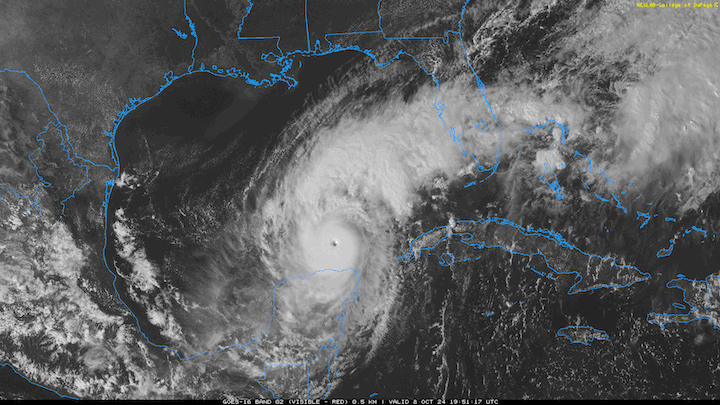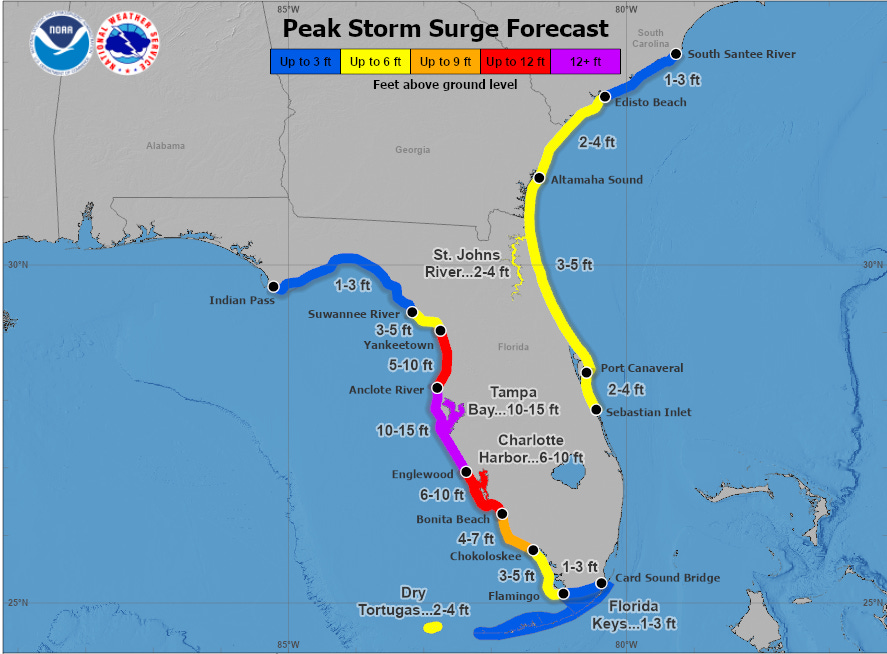
This is a re-post from the Climate Brink by Kevin Trenberth
Have there been other years where multiple hurricanes hit Florida? That is one of the questions I am now getting. The answer is yes: in 2004, for instance.
The summer of 2004 was when four hurricanes made landfall in Florida, and the question was whether there was a human global warming role in the activity and thus the damage. To me it was obvious that there was.
I had worked extensively on climate change, and had connected the increases in sea surface temperatures, which were clearly and demonstrably linked to global warming, to increases in water vapor in the atmosphere.
This link is strong and physically based: over the oceans, where there is ample water at the surface, the water vapor goes up at 7% per 1C warming, the same rate as the atmosphere’s ability to hold water vapor. Accordingly, all storms reach out and gather in the available water vapor, which fuels the storm, and it rains harder. I reasoned that this should also apply to hurricanes.
None of this was reflected in any official 2004 NOAA statements on hurricanes and instead the extra activity was all attributed to natural variability. I agreed to participate in a news conference on the topic, set up by Harvard University, in which I cautiously suggested that yes, global warming was undoubtedly playing some role.
This led to a major outcry from the hurricane meteorologists, who were amazingly ill-informed about climate change matters. I did not answer the criticism directly, and instead published my views in a perspective in Science magazine in June 2005.

The timing was fortuitous as it preceded the record breaking 2005 hurricane season in which Katrina devastated New Orleans. Two other studies came out shortly thereafter. One was by Kerry Emanuel, and another was a paper led by Peter Webster.
Peter and his colleagues had thought that my comments were not correct and had set out to prove this. Instead, they found that I was correct, and they were converted, at least temporarily, from skeptics to global warming adherents, and they in turn became targets of the skeptics and hurricane forecasters. It was nice to no longer be the sole target of the deniers with regard to hurricanes issues.
In July 2007 I published a general article on the topic of hurricanes and climate change in Scientific American. The material there has stood the test of time very well. A recent paper that deals with this was on 2017’s Hurricane Harvey.
Harvey, Maria, and Irma, were the main hurricanes that year, although there were 17 named storms and 10 hurricanes, 6 of which were categorized as “major.”
Incidentally, we had trouble publishing this paper because of its multi-disciplinary nature (by including impacts and consequences). A summary and excerpts follows:
Human-induced climate change continues to warm the oceans, which provide the memory of past accumulated effects. The resulting environment, including higher ocean heat content and sea surface temperatures, invigorates tropical cyclones to make them more intense, bigger, and longer lasting and greatly increases their flooding rains. The main example here is Hurricane Harvey in August 2017, which can be reasonably isolated in terms of influences on and by the environment.
Hurricanes keep tropical oceans cooler as a consequence of their strong winds that increase evaporation. Here we show for the first time that the rainfall likely matches the evaporation and the corresponding ocean heat loss. Planning for such supercharged hurricanes (adaptation) by increasing resilience (e.g., better building codes and flood protection) and preparing for contingencies (such as evacuation routes, power cuts, and so forth) is essential but not adequate in many areas, including Texas, Florida, and Puerto Rico where Harvey, Irma, and Maria took their toll.
Consequently, while hurricanes occur naturally, human-caused climate change is supercharging them and exacerbating the risk of major damage. It is generally expected that storm and hurricane activity will be affected by climate change, primarily because all storms occur in a warmer and moister environment, increasing precipitation and thus latent heat release, with feedbacks on moisture convergence (Trenberth, 2005; Trenberth and Fasullo, 2007).
For tropical cyclones (TCs; including hurricanes or typhoons), the general expectation is for more activity (Emanuel, 2007, 2013; Trenberth and Fasullo, 2008). There may be fewer but more intense storms (i.e., relatively more Category 4 or 5 storms), in part because of changes in atmospheric stability, and in part because a few bigger storms can replace many smaller storms in terms of their impact on the ocean (Trenberth and Fasullo, 2008).
However, these results largely come from global modeling experiments that only coarsely resolve tropical storms, whereas dynamically downscaled experiments find increases in both frequency and intensity (Emanuel, 2013). Tropical storms and hurricanes spin up very strong winds which increase the surface evaporation (latent heat) by an order of magnitude or more (Trenberth et al., 2007). The increased atmospheric moisture flows into the hurricane and fuels the storm itself.

As the intensity increases, spiral arm bands become more circular and can form a new eye wall, known as eyewall replacement, where the new eye wall has a much larger radius. They then recover strength and hence live longer. Such eyewall replacements occurred several times in Irma, resulting in a very large hurricane.
The main impact of climate change on hurricanes arise through the changed environment, especially the warmer oceans. Hurricanes form naturally, and come in all sizes, locations, and tracks, and the activity can be manifested in several ways, through the intensity, size, lifetime, and number of the storms, and good statistics exist for only a few of these variables.
Climate change increases the activity as a whole, but there is competition among basins for where this occurs, and, because it can be manifested in several ways whose integral effects are poorly measured, there remains considerable uncertainty over just what has happened and can be expected in the future. Nevertheless, the risk is clear, and preparations for expected effects of climate change on hurricanes and more generally are woefully inadequate.
Posted by Guest Author on Monday, 14 October, 2024
 |
The Skeptical Science website by Skeptical Science is licensed under a Creative Commons Attribution 3.0 Unported License. |